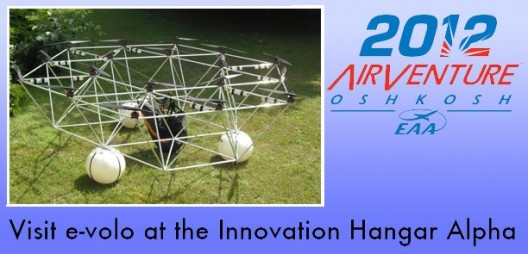Thomas Senkel of the German firm e-volo sends this video, the official promotional video for these multi-rotor vertical takeoff and landing aircraft at AirVenture 2012. Better yet, the team will have at least their prototype machine on hand and many displays of future developments. Note the modular structure of these vehicles at the end of the video.
Innovation Hangar Alpha will house the VC2 Volocopter, successor to the VC1 and improved in many ways, including three pilates balls for bouncing your landing on. The VC1 was the first “purely electrically powered, vertical take-off and landing (VTOL) aircraft and flew last October. At least the pilot is under the spinning rotors on this version.
Seriously, the designs represent a clever and elegant design concept, which embodies ease of control and simplicity of operation. The software which enables smooth flight and nuanced control has to be a marvel of programming.
The VC2 is not only a more sophisticated design, but lighter and stronger. Starting in September, test flights will include extensive study of safety factors, motors, steering controls and battery management.
Tests aim to develop a two-seat Volocopter which complies with regulations and which can demonstrate the following performance:
• A speed of over 54 knots (100 kilometers per hour or 62 mph)
• A minimum flight altitude of 6500 feet
• A take-off weight of 450 kg (990 pounds)
• More than one hour flight time
Development will include a two-year flight test program with the LBA (German Federal Aviation Office) and the DULV (German Ultralight Aircraft Association). The group plans
“autonomous flights over uninhabited areas for days on end” to demonstrate reliability, controllability, and safety of the concept.
Lucky Oshkosh goers will get a glimpse of one facet in an ever more fascinating future.


Comments 2
I don’t get it! All those props and you still need one in back? Jerry
(Editor’s Note: Designers say it adds forward thrust, creating speed without vectoring lift rotors to produce forward motion.)
1) one 20 inch RC propeller cannot lift 10kg, it will stall
2) the pilot do not move a muscle when flying, except a fast unnatural head glitch
3) the video do not show the pilot’s face during fly
4) there’s no continuity from sitting to fly to stand up